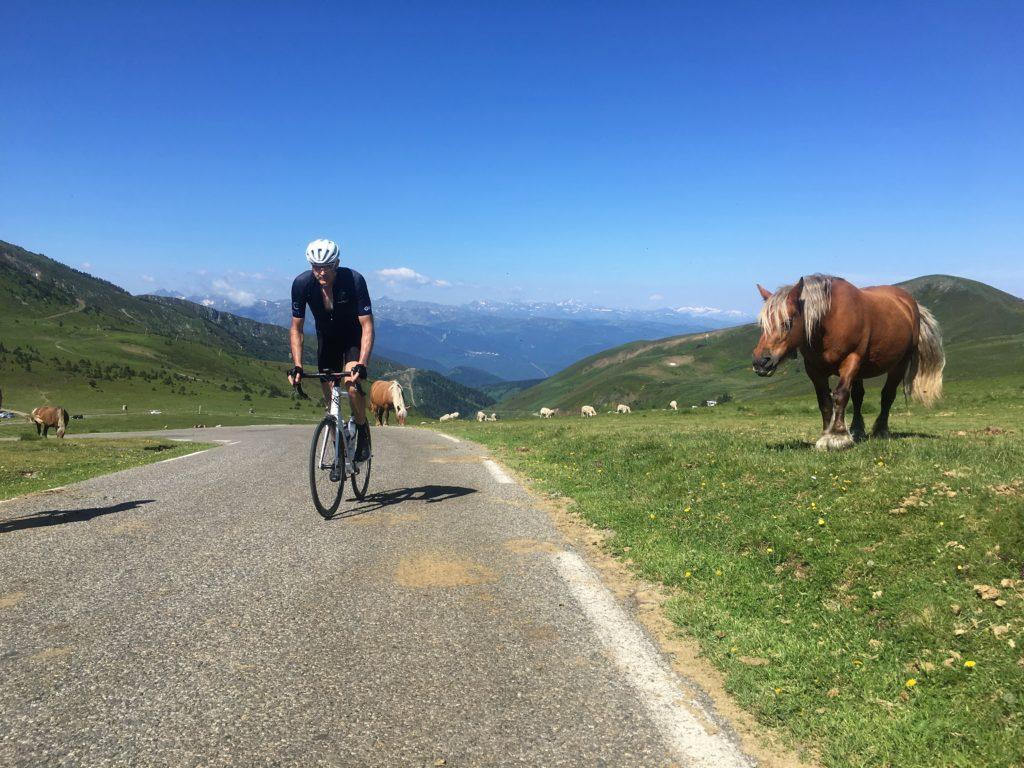Why a training plan works (3/3)
By from Nigel Hale Hunter from BPM Coaching
Overtraining
If you want to keep cycling and improving, set yourself sensible measurable goals and take measured and sensible steps to reach them. When planning your training think about your other commitments, home life, work, social life, there needs to some compromise to allow time for your training. However, perhaps your cycling should not become an obsession at the expense of everything else. Your life will already have a stress loading and training will in some ways add to this. Training and your life need to be considered as a total package and you need to commit to what is manageable and not detrimental to your overall welfare. Having said all that, cycling and exercise present massive benefits to your wellbeing so long as you manage the balance correctly.
Overtraining should under normal circumstances not be an issue within the parameters of your training plan or schedule. However, it is important you understand the principles and know what to be aware of in case other factors affect your wellbeing and particularly as you progress to more intensive training regimes.
What we now call overtraining was once referred to as staleness, burnout, or chronic fatigue. We now recognize overtraining as a complicated condition with many different symptoms, a syndrome.
What we call overreaching, applies to short-term overtraining, this might happen after a particularly hard training session. It usually occurs in the few days following a longer, more strenuous ride.
The term overtraining applies to longer more chronic overtraining, conditions that result after weeks or months of training without adequate rest and nutrition, compounded overreaching if you like. This is a more serious condition requiring long periods of rest, nutrition, and perhaps medical intervention. In contrast, overreaching can normally be addressed with a few days of rest and a few hearty meals.
Overtraining has been the subject of a great deal of research and as a result, its causes, prevention, and cure have become less of a mystery.
Training combined with all your other activities, all of which use energy and may be stressful, can bring about a state of chronic fatigue which we call overtraining. It is important to consider your life balance before making a commitment to training that may be unsustainable or damaging. The failure to allow adequate time for proper food, rest, and recovery, can potentially be both physically and physiologically damaging. As stress and fatigue levels increase the immune system may become depressed, making you more prone to minor infections. Worse still this level of training is also ineffective. Once training starts to produce results, it is tempting to assume that if we train harder and longer, we then do even better. When inevitably performance levels level off or even decline, you may train still harder thinking this is the only way to improve. You are now overtraining, and this will lead to both the physiological and physical problems associated with overtraining and chronic fatigue. These symptoms can be varied, long-term and often severe, it is really not a matter to be taken lightly. Prevention is far easier than cure. If you think that you are suffering from overtraining, see your doctor or medical advisor.
Although overtraining is a complex subject monitoring your heart rate can help avoid overtraining. By comparing heart rate readings, you can spot the early stages of overreaching (accumulated training stress) that can lead to overtraining if action is not taken.
To use your heart monitor effectively to help you avoid overtraining, you need to understand your relationship with both your Resting Heart Rate (RHR) and Your Heart Rate Recovery (HRR).
- Record and monitor your exercise heart rate response to a given workload (HRR) as often as possible. The results should be documented over days, weeks, and months.
- To set a baseline perhaps pick a target power in exercise zone 2, 3 & 4. Make your rotations and warm up for progressively through exercise zone 1, 2 and 3 for 15 minutes. Then cycle for 5 minutes at your target power for exercise zone 2 and record your heart rate after 4 minutes. Repeat this cycle for target powers in exercise zones 3 and 4. You have another option at this point, you could move up to an exercise zone 5 target power and keep going as fast as you can until you hit a target heart rate of for example between 150 or 170bpm. Then stop and record then record your heart rate fall after 1 minute. Afterward, cool down for 15 minutes and do your stretches or you could go straight into your cool down.
- The best way to find your resting heart rate is to take it first thing in the morning when you wake and before you do anything every day for a week and then work out the average over that period. Put your heart rate strap on and just lie there for a couple of minutes, trying to relax as much as possible. Note the lowest figure you see and repeat the procedure the following day. There are now many smartwatches that automatically record your resting heart rate and your hours of sleep. This information can be used to monitor your wellbeing.
Do not be fooled by thinking that having a low resting heart rate means you are super-fit. Generally speaking, a low resting heart rate is indicative of a well-trained athlete, but it is not always the case. There are people who have a genetically low heart rate or high heart rate regardless of fitness. We have all heard people compare early morning resting heart rates and heart rates during rides. However, there are great differences in individuals normal resting heart rates, you can only compare values with your own previous results. The reason for this is simply that we are all different with different anatomy. However, our anatomy and systems are all based on the same physiological mechanisms.
Thus, we can learn from each other’s physiological experiences and adaptations, but we cannot compare individual heart rate values. For example, your resting heart rate is perhaps 58bpm while your friend’s resting heart rate is 42bpm, still, we could not say from this alone which one of you are in the best shape nor have the highest VO2 max. You will probably already have noticed that your resting heart is lower when you are in good shape. This is because of a larger stroke volume and is one of the central adaptations brought about by endurance training. The resting heart rate is closely related to the autonomic nervous system.
Heart Rate Recovery in more detail
As we mentioned above heart rate recovery (HRR) is the rate at which the heart rate returns to baseline after a period of exercise. Again, as a simple and useful test is to take your heart rate up to a set figure between perhaps 150 and 170bpm on a short climb and then stop and record your heart rate after 1 minute’s rest. Start comparing results week by week, if it is not dropping as far, it is perhaps a sign of overtraining.
Complete recovery of the heart rate may take an hour after light activity, several hours after long-duration aerobic exercise, and perhaps 24 hours after intense exercise. You should make sure this is the case before proceeding with a session on a higher-intensity workload the following day. One quick way to check and measure HRR (heart rate recovery) is to measure the change in heart rate during the first minute after submaximal exercise. A drop-in heart rate of 15-20 beats per minute might be typical and a value less than 12 would be unfavorable. It important to understand how your heart rate should respond both at rest and during exercise as you train. Make sure it is increasing and decreasing as you would expect.
However, again as your fitness improves your heart rate should decrease both at rest and in response to a fixed workload. The decreased heart rate response under both situations is a result of the improved cardiovascular function, amongst other improvements the heart has undergone adaptions and can now with an increased stroke volume move more blood with each beat. While you are still recovering from exercise your heart rate at rest will be elevated because it is still working on repairing tissues and replenishing fuels. What is more, before you are fully recovered, your heart rate during exercise will not increase to where it needs to be to adequately supply the blood required by your muscles. This will result in a feeling of sluggishness which is often experienced during early overreaching. As you try to raise your heart rate by working harder the situation worsens and in doing so becomes frustrating. The workout becomes non-productive and the best thing you can do is rest.
Several important and useful observations have been made about HRR:
- A slight increase in HRR accompanies a fitness gain during a training cycle or period.
- An unexpected increase in HRR may indicate fatigue due to training.
- A decrease in HRR during a training cycle or period may indicate overtraining.
- Using this information, we can use HRR as a physiologic barometer to help gauge the effects of training as well as the readiness to race.

Why know your resting heart rate
A good reason to know your normal level of resting heart rate is that you can again use it to alert you to possible overreaching/overtraining or illness. If your resting heart rate is 10-15 beats above normal, you may well be ill. In that case, it is recommended you take your temperature and look for other symptoms. Again, avoid training or races if you don´t feel well.
Although you are training to a plan it is not fixed in stone when we come to this important issue. You need to be open-minded enough to change your plan if you think you are overreaching or even overtraining. If you think this is the case as a precaution simply cut back on the volume of exercise you are doing for a few days, get some early nights and ensure your nutrition is good. Overreaching which generally occurs when there is a marked increase in intensity or volume. This quite often happens to athletes when attending a training camp and can be easily addressed in this way.
Simple self-assessment
To determine whether you are overreaching or overtraining ask yourself three questions. (1) Are you finding your exercise sessions getting more difficult or easier? If they are getting more difficult and they are the same workouts at the same intensity, you are overtraining. (2) Are you very tired but having trouble getting good-quality sleep? If so, you are overtraining. (3) Do you find it difficult to exert maximum effort during a routine training session? If so, you are overtraining. These three simple questions will help you determine whether you are starting to overtrain.
The feel-good factor
Asking yourself some basic questions and recording the answers on a simple scale can provide an early warning that might perhaps be signal overreaching that could lead to overtraining.
- How do I feel today?
- How did my training feel today?
- How did I sleep last night?
- How is my appetite?
- Am I worried about anything that could affect my performance?
Simply rate yourself on a scale of 1 to 10. Adding up the answers and comparing the sum with previous results. The advantage of an early warning is that you can take remedial action at once. If the problem is in its early stages a short break from training, followed by a resumption of low volume work after a few days may be enough.
Ignoring your assessment of your current well-being and the symptoms that present themselves by continuing to train to the same regime will inevitably lead to chronic overtraining, normally accompanied by a period of illness as a result of a compromised immune system. You could be facing several weeks or possibly several months away from exercise and as we have said it can be worse. Do not ignore what your body is telling you.





